7+ SAMPLE Copyright Disclaimer Statement
-
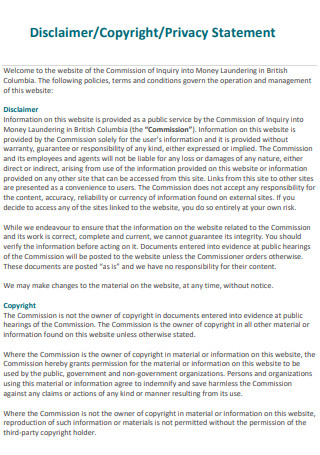
Copyright Disclaimer statement
download now -
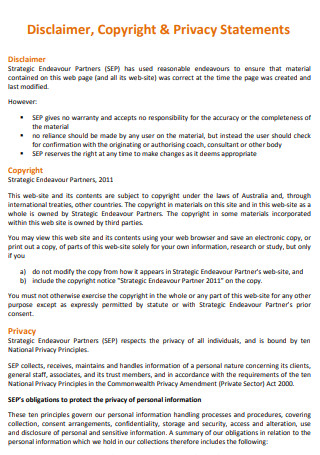
Copyright Disclaimer Privacy statement
download now -
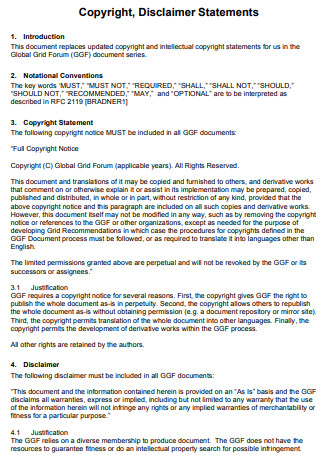
Sample Copyright Disclaimer Statement
download now -

Copyright Disclaimer Statement for Website
download now -
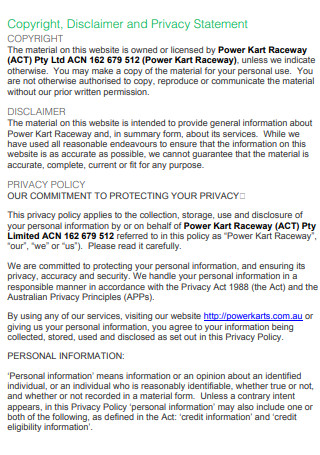
Formal Copyright Disclaimer Statement
download now -
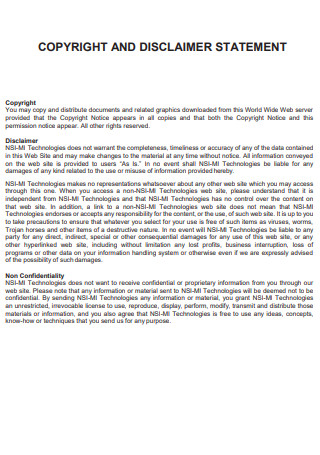
Copyright And Disclaimer Statement
download now -
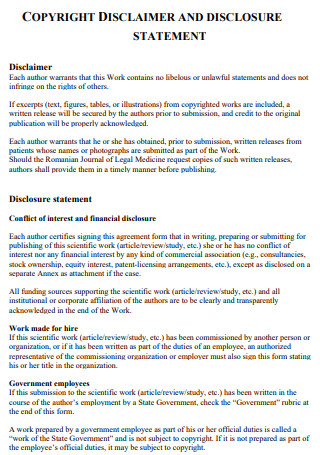
Copyright Disclaimer Disclosure statement
download now -
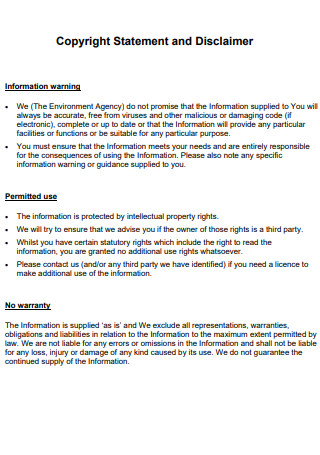
Copyright Disclaimer statement Example
download now
FREE Copyright Disclaimer Statement s to Download
7+ SAMPLE Copyright Disclaimer Statement
What is a Copyright Disclaimer Statement?
Parts of a Copyright Disclaimer Statement
Kinds of Copyright Protections
Rights of Copyright Owners
Steps in Preparing a Copyright Disclaimer Statement
FAQs
What is the difference between copyright and trademark?
Who qualifies as a copyright owner?
How long does copyright protection last?
What is a Copyright Disclaimer Statement?
Before we get into the copyright disclaimer statement, what is copyright? By definition, copyright refers to a type of intellectual property that protects the original works of the author who filed for it from getting unlawfully reproduced and distributed. Since copyright also means “the right to copy”, it basically means that only the author and anyone granted authorization by the author gain the exclusive right to distribute and reproduce it.
A copyright disclaimer statement is a statement document that serves to claim ownership of the original work, such as music, a literary write-up, or a film. This statement can appear on content that makes use of another copyrighted content, which includes a statement of fair use to avoid a copyright infringement claim. This statement can also appear on websites such as social media to establish ownership of the work. Having this statement protects against theft.
Parts of a Copyright Disclaimer Statement
The copyright disclaimer statement usually only consists of the following elements:
- Name – This element of the copyright statement states the name or author of the original piece of content. It can be your personal name or the business name who owns the content with copyright protection.
- Year – This element of the copyright statement states the year in which the original content was produced, not registered.
- Copyright Symbol – This element of the copyright statement denotes the symbol of copyright, which is “©”. This is usually written before the name of the author or the year that the content was produced.
- Reservation of Rights – This element of the copyright statement signifies that the original author of the work retains full legal rights in order to warn others of those rights. This is usually denoted by the “All Rights Reserved” statement.
Kinds of Copyright Protections
There are different kinds of copyright protections, and they vary by the type of work that is to be registered for copyright protection. Here are those:
Rights of Copyright Owners
Now that you’ve successfully applied for copyright protection, you ask yourself about the rights that you actually hold. Listed below are the rights that you need to know:
Steps in Preparing a Copyright Disclaimer Statement
Now that you’ve known what a copyright disclaimer is, it’s time to prepare the appropriate copyright disclaimer statement that is to be included in your work. Having this statement can act as an effective deterrent towards people who attempt to commit copyright infringement. With that being said, this statement is relatively easy to prepare, and here are the steps you can follow:
-
1. Select the Piece of Work
This is the first step of preparing the disclaimer statement. To begin, select a piece of work such as your own audio recording, your own literary device, or your own audiovisual film. Once you’ve selected the medium of your choice, apply for copyright protection. Depending on where you are, this can be a relatively simple or complicated process. Once you’re successful, proceed to the next step. If you intend to use a work under fair use that has been copyrighted, you need to explicitly state it in the next steps.
-
2. Add the Necessary Information
After you’ve selected the work of your choice, now is the time to add your information such as the name and the date or year when the content was produced. In the case of printed media, the information is added on the title page or the page before, or the page after. In the case of digital media, the information can be edited on the metadata of the file, and on web media, the information is usually located at the bottom of the page or it can also be hyperlinked to a specific page.
-
3. Add the Copyright Symbol, the Main Disclaimer, and the Reservation of Rights Statement
This is a relatively easy step, but it can be considered the most important one. Whenever you add the main disclaimer, explicitly state that the work of concern is under copyright protection. If you’ve selected a work that is copyrighted, state that you are using the work under the terms for “Fair Use”. You must also credit the original creator in the disclaimer. To add the copyright symbol “©” on web media in a Windows computer, the combinations of Alt + 0169 on the Numpad part of the keyboard are all that is necessary. You have to hold down the Alt key while pressing the numbers in order for this to work. Then, add the reservation of rights statement, which usually states “All Rights Reserved.” Keep in mind that the copyright symbol is to be added before the name of the original author, and the reservation of rights statement is added after the year. An example of this would be “© John Smith, 1994. All Rights Reserved.”
-
4. Place the Finished Elements Accordingly
This usually serves as the final step in creating the copyright disclaimer statement. The statement should be placed accordingly and it depends on what media is used. As stated earlier, in printed matter, you can place the entire disclaimer on the front page or on the back page, as long as it is clearly visible. And on media placed on CDs or DVDs, the disclaimer can be placed on the back part of the cover. And on digital media, the copyright notice is usually edited onto its metadata.
FAQs
What is the difference between copyright and trademark?
Aside from the symbols, with copyright being “©” and trademark being “™”, the difference between copyright and trademark is that copyright protects original work, is generated automatically when original work is created, and expires after a set period of time, whereas a trademark protects items that discern or identify one enterprise from another, is established through widely accepted use of a mark in the course of trade or business and does not expire as long as the mark is used.
Who qualifies as a copyright owner?
Anyone qualifies as a copyright owner. It basically means that you don’t have to hold a particular title or rank in your business to be able to apply for copyright protection for your own work. To explain further, you are the creator and proprietor of an original work once you make it and fix it, such as shooting a photo, writing a piece of poetry or blog, or releasing new music. Copyright can also be owned by companies, organizations, and individuals other than the creator of the work. Copyright law recognizes ownership through for-hire works, which stipulates that works generated by an employee while on the job are held by the employer. Ownership may also come from signed contracts.
How long does copyright protection last?
The length of copyright protection is determined by the exact date on which it was created. If it was produced on or after January 1, 1978, have a copyright term of the author’s life plus seventy years after the author’s death under current copyright laws. On the other hand, if the work is a collaborative effort, the term lasts seventy years after the death of the last living author. Lastly, if the work was created on a for-hire basis or if it was created anonymously or under a pseudonym, the copyright protection for that work will last for a very long time, usually 95 years from publication or 120 years from creation, whichever duration happens to be shorter.
Copyright Disclaimers serve as a necessary measure for anyone. Whenever you own copyrighted works, such as literary pieces, music, or photographs, it is very necessary to disclose your copyright ownership so that intellectual property theft is prevented. To repeat, should you want to use copyrighted work, you may only do so under the terms of fair use, and it must also be appropriately disclosed. If you want to make a copyright disclaimer statement, you can refer to the steps written in the article or through the examples that are posted above.
